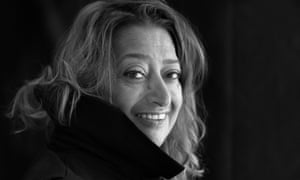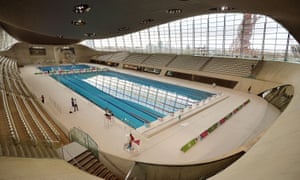
//

//
In the London of the early 1980s, when Zaha Hadid, who has died aged 65 after a heart attack, first opened her own office in a small room in a redundant Victorian school in Clerkenwell, the idea that she might one day become one of the world’s most celebrated and successful architects would have seemed far-fetched. At a time when most architects were still under the lash of the Prince of Wales, camouflaging their work with a constipated brick and tile skin, or decorating their facades with fragments of postmodern confectionery, Hadid was not building anything. She was working night after night, essentially living in the drawings that flowed from her pen in an apparently unstoppable flood. They conjured up glimpses of a world she had imagined but which did not, as yet, exist. For those who didn’t get it, her work was seen as just too difficult. And she wasn’t going to try to ingratiate herself with those who did not understand her.
The most visible results of that period are a series of huge paintings that hinted at what she might build if she had the chance. They did not depict anything that could be conventionally identified as a building, but instead showed jagged landscapes in which walls and roofs, inside and outside, ground plan and cross section, merged seamlessly one into another. They were more like Piranesi dreamscapes than rational proposals for orthogonal buildings. But these were not abstractions or fantasies: they were the product of Hadid’s exploration of new ways to imagine how space might work, inspired in part by the drawings of the Russian artist Kazimir Malevich, whom she discovered when she was still a student.
//
The most famous of them were made for the competition she won in 1983 to design a resort complex in Hong Kong, known as The Peak. A series of overlapping cantilevers jutted out into space, providing layers of accommodation, bars and restaurants, as well as hotel rooms. The eminent engineer Peter Rice, who had worked on the Pompidou Centre in Paris, endorsed them as entirely buildable, but the client turned out not to have the cash. It was a failure to launch that is common in most architectural careers, where unbuilt schemes outnumber built projects by a large margin. But in Hadid’s case it was the start of what became a persistent theme for her critics. Hong Kong was not built; neither, 10 years later, was the Cardiff Bay Opera House. Most recently, her competition-winning design for Tokyo’s Olympic stadium was scrapped. She was blamed for all these, unfairly attacked for her personality as well as her competence.
The ideas that she was working through in the 1980s were most convincingly realised in the Heydar Aliyev centre, the cultural complex that she built in Baku, Azerbaijan, 30 years later. It resembles a gravity-defying snow-white iceberg that erupts from the ground like a twisting rollercoaster. And unlike some of her projects in which corners have been cut by builders in a hurry, Baku was beautifully finished, inside and out. Her critics saw this building as the glorification of a repressive and sinisterly authoritarian regime. For Hadid, it was the product of the negotiation with power that has always been part of the practice of architecture.
//
Daughter of Mohammad Hadid and Wajiha al-Sabunji, she was born in Baghdad. Her father was a liberal politician who sent Zaha to a convent school despite being a Muslim. One of her brothers, Foulath, became an Oxford academic – Zaha later built a library for his college, St Antony’s. She grew up in a secular, modernising Baghdad at a time when Le Corbusier had been commissioned to build a sports complex, Frank Lloyd Wright was working on a cultural centre, and Walter Gropius had built a university campus. These were projects that she acknowleged might have inspired her choice of career, and certainly gave her a sense of the transformative power of architecture.
Later she went to an English boarding school, gained a maths degree at the American University of Beirut, and then, most importantly, studied at the Architectural Association school in London. The AA had become a hothouse, a licensed opposition in which dissidents and dreamers created an architecture, mainly on paper, that had nothing to do with the bleak architectural climate of the time.
The school in those days was led by Alvin Boyarsky, whom Hadid always cited as one of her most important influences. Her two most important teachers, apparently at the opposite ends of the architectural spectrum, were Leon Krier, who went on to become a close adviser to the Prince of Wales, and Rem Koolhaas, who uses the world brutal as a compliment. For many years, both Krier and Koolhaas presented building as a kind of sell-out. Hadid matched their reluctance to compromise but was always determined to build.
////
//
//
http://ara.reuters.com/article/entertainmentNews/idARAKCN0WX22L